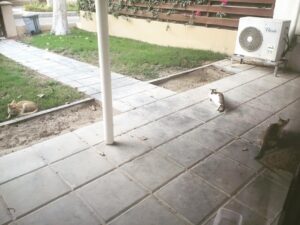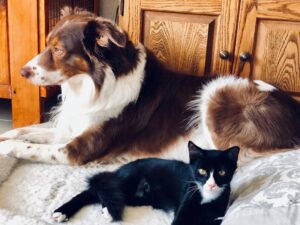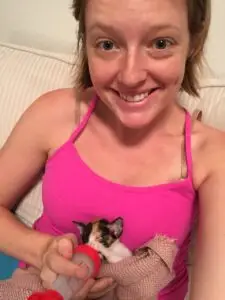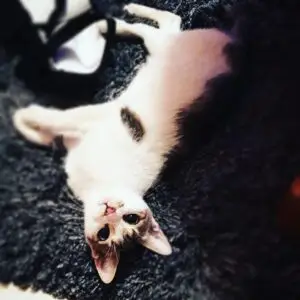It all started in Saudi Arabia. I lived in a quiet compound filled with kids on bikes, neighbors sipping tea outside, and—yes—cats. Dozens of them. They lounged under park benches, peeked out from palm fronds, and gathered every evening at the same spot, waiting for someone with a kind heart and a tin of food.
That someone, eventually, was me.

I started walking the compound every evening with a little bag of kibble and wet food in my bag. What began as feeding a few regulars quickly turned into something bigger: learning how to trap, neuter, and return (TNR). I wasn’t a vet or an animal expert. I just saw a problem and wanted to help. I teamed up with a few other residents—people from all over the world who also cared—and we built a small but mighty community of humans who believed these cats deserved better.
Not everyone was thrilled, at first. Some thought we were taking away kittens. Kittens people “wanted” to see grow up. Others didn’t understand why we’d neuter outdoor cats at all. But with patience, education, and consistency, we helped shift the mindset. These weren’t pests. They were part of the neighborhood. We didn’t take away—we gave back: healthier cats, fewer kittens dying in bushes, and less nighttime howling. We helped dozens of cats over time—and I even adopted two of them myself. They flew halfway across the world with me, and are still with me today.

Now that I’m in Shreveport, I see the same patterns playing out here. Neighborhoods with big-hearted people. Cats everywhere. And a growing need for simple, kind solutions like TNR.
🕵️♀️ How to Spot a Colony
You don’t need to be an expert to get involved—you just need your eyes, ears, and a little time.
Signs of a colony include:
-
- Multiple cats sticking to the same yard, alley, or lot.
-
- Empty food bowls or makeshift shelters (someone may already be feeding them).
-
- New kittens appearing every few months.
-
- Some cats missing the tip of one ear (that’s the international sign they’ve been fixed—called “ear-tipping”).
Just by observing for a few days, you’ll start to see patterns: who’s in charge, who’s shy, who’s limping, who needs help.
🧼 Keeping the Colony Clean and Healthy
You’d be surprised how much cleaner and healthier a managed colony is compared to one left on its own. Here are a few simple things I’ve learned to do:
-
- Feed on paper plates not directly on the ground
-
- Pick a regular feeding time and stick to it—cats love routine.
-
- Offer fresh water daily (especially in the Louisiana heat).
-
- Watch for signs of illness like sneezing, coughing, limping, or wounds.
You don’t have to do medical care yourself. Just knowing when to call a rescue or vet can make all the difference.
👶 What About Kittens?
Here’s a tip I learned the hard way: Don’t rush to “rescue” every kitten.

Kittens under 6 weeks old are much better off with their mother. Even if she’s feral, she’s giving them warmth, milk, and important survival skills. Unless they’re clearly abandoned, give them time—and keep an eye on them.
When they’re old enough, that’s when we step in: trap the whole little family and work on fostering, socializing, or TNR.
🛠 Want to Help? Here’s Where to Start in Shreveport/Bossier:
-
- Start feeding—pick a spot and stick to it.
-
- Look for ear-tips. No ear tip? That cat likely needs to be fixed.
-
- Reach out to a local rescue—like The Kitten Cradle, Port City Cat Rescue, Caddo Animal for free Spay and Neuter events or even Bossier Animal Control—for traps.
-
- Team up with neighbors. One person feeds, another traps, another drives to the vet. Team work makes the dream work
🗣 A Call to Our Local Community
I’ve seen firsthand how a group of people can change the lives of dozens—even hundreds—of cats, just by deciding to help.
We have a TNR ordinance in Shreveport. We have low-cost clinics (Robinson’s Rescue, Caddo Animal ), willing volunteers, and people who care. What we need is more folks to take that first step—to look at a cat in a parking lot and think, “I can help.”
You don’t need to do everything. Just do something.

